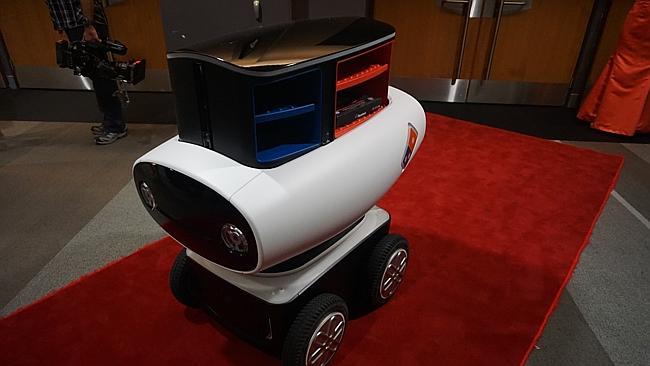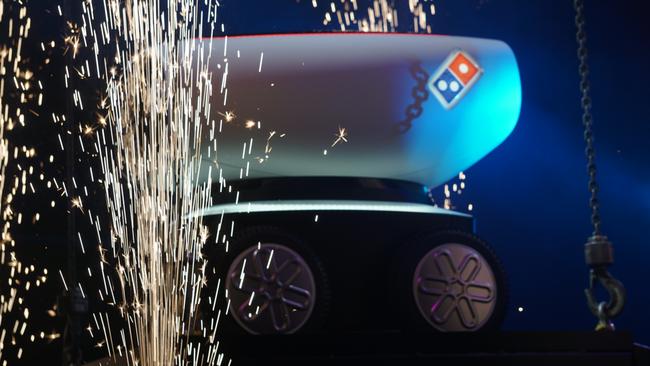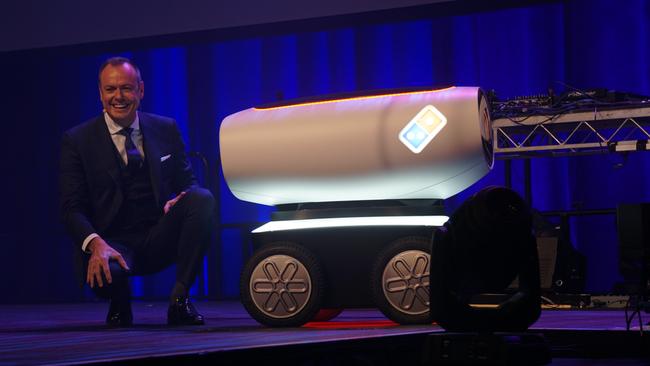Domino’s unveils robot delivery boy
Domino’s has unveiled an autonomous vehicle that will deliver pizza and accept payment from customers | WATCH

Domino’s has unveiled an autonomous delivery vehicle designed to sleek along footpaths, delivering pizza, and accepting payment from customers, without a human aboard.
The vehicle, known as DRU for Domino’s Robotic Unit, uses GPS to find its way around cities and even travel along bikepaths to its destination. DRU is a four-wheel vehicle with a maximum speed of 18km/hr with compartments for pizzas and drinks.
Domino’s Group CEO Don Meij unveiled DRU in Brisbane last night. He wouldn’t reveal development costs, but he estimated each DRU would be worth $30,000. He expected the first DRU to be rolling around Brisbane, where Domino’s is headquartered, in 6 months time.
The reality is there are enormous obstacles to overcome before anything like DRU is seen around town.
First, the robotics involved has to be capable of avoiding obstacles. DRU has to be able to dodge curbs, obey traffic lights, read road and pedestrian signage, not run over homeless people asleep on the footpaths, not run down children, and ward off barking dogs.
What happens when the only way ahead is up a staircase? It would also have to avoid getting bogged in the mud scuttling across a park. DRU will need demonstrably bulletproof collision avoidance technology, otherwise it’s an 18km/hr unmanned projectile hurtling down the footpath.
Domino’s didn’t give any assurance of just how far the development had gone with this only that it was heavily involved in advanced robotics.
The only indication was 6 months of work in its purpose built “DLAB”, with robotics work undertaken by Sydney-based start-up Marathon Robotics.
In addition, $30,000 robots would be obvious targets for theft or “robot-napping”, and there’s the prospect of hackers having a field day diverting them off route.
The biggest obstacle is regulation. Local and state governments would have to be totally convinced of the sophistication and capability of the robotics on board before allowing anything like an autonomous or remotely driven vehicle among the public. And that is likely to be years away.

Mr Meij said he had held some talks with local government and in a statement Domino’s said it had been working with the Queensland Department of Transport and Main Roads and other authorities. It said agencies have been “very supportive in the process to date”.
Domino’s said it had conducted some test deliveries under a restricted permit.
There’s too the economics. Does it make sense to replace a crew of pizza delivery motorbike riders and cyclists earning what is basically pocket money with a $30,000 robot? And how would it get pizza up the stairs to the front door?
While DRU poses more questions than it answered, it’s a case of never say never.
One day we might share our footpaths with autonomous delivery vehicles, our roads with autonomous, driverless cars, and our skies with drones ferrying parcels across town.
There is the prospect that the increasing maze of bike paths around our cities could be where we encounter unmanned vehicles performing all sorts of roles — not just delivering pizza. We’ll need to see DRU out on the street functioning, with its LIDAR collision avoidance capability fully operating, before giving it the thumbs up.
DRU is an electric vehicle with a 20km range, an in-built LIDAR detection system aimed at obstacle avoidance, weighs about 190kgs, and 1.185m high. It is made from ABS and urethane plastics.
* Chris Griffith attended the launch of DRU in Brisbane courtesy of Domino’s.




To join the conversation, please log in. Don't have an account? Register
Join the conversation, you are commenting as Logout